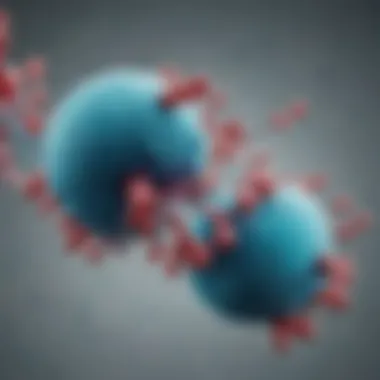Exploring Plaquenil's Role in Rheumatoid Arthritis Treatment


Research Overview
Plaquenil, or hydroxychloroquine, has surfaced as a significant therapeutic option in the management of rheumatoid arthritis (RA). This section will delve into the various facets of its role, focusing on key findings from recent studies and the methodologies employed in researching its effectiveness.
Key Findings
Research indicates that hydroxychloroquine can help in moderating the progression of rheumatoid arthritis, leading to an improvement in joint symptoms for many patients. Some critical findings include:
- Immune Modulation: Patients show less joint pain and tenderness due to hydroxychloroquine’s ability to alter immune function and decrease inflammation.
- Radiological Improvement: Studies suggest that consistent use of hydroxychloroquine may lead to better radiological outcomes, helping to preserve joint integrity over time.
- Adjunct Therapy: It’s often discussed as a part of a broader treatment regimen alongside other DMARDs (disease-modifying antirheumatic drugs) like methotrexate, showing synergistic benefits in managing RA.
Study Methodology
The investigations into hydroxychloroquine’s efficacy typically involve a blend of randomized controlled trials and longitudinal observational studies. For instance, trials often assess diverse patient demographics to ensure results are widely applicable, employing varying dosages and combinations with other medications:
- Sample Size and Diversity: Researchers recruit participants from various backgrounds, considering age, disease duration, and previous treatments.
- Duration of Study: Many studies extend over several months to years, permitting a clearer viewpoint regarding both short-term effects and long-term sustainability of benefits.
- Outcome Measures: Commonly used measures include the Disease Activity Score (DAS) and the American College of Rheumatology (ACR) criteria, providing standardized benchmarks for assessing improvement.
Background and Context
Historical Background
The use of hydroxychloroquine in RA dates back decades, originating as an antimalarial drug. Initially employed in treating malaria, its potential applications for autoimmunity were gradually discovered. This repurposing was particularly significant in the mid-20th century, propelling hydroxychloroquine into common use for not just RA, but also lupus and other autoimmune diseases. Its endorsement by the medical community hinged on a favorable safety profile and an increasing body of evidence familiarizing clinicians with its benefits.
Current Trends in the Field
Today, the relevance of hydroxychloroquine is amplified by ongoing discussions around personalized medicine. Clinicians increasingly consider factors such as genetic predispositions and patient lifestyle when prescribing hydroxychloroquine. Alongside growing interest in its long-term effectiveness, the drug is examined under the lens of pharmacogenomics. Such advancements are enabling more targeted approaches to treating RA:
- Integration with Biologics: In light of increasing knowledge about treatment resistance, hydroxychloroquine is now being explored for its potential when paired with cutting-edge biologics.
- Real-World Evidence: Studies aiming to evaluate the drug's performance in everyday settings reveal insights into its practical application and effectiveness across varied patient bases.
"Hydroxychloroquine stands as a multifaceted agent in the toolkit against rheumatoid arthritis, continuously evolving with our understanding of the disease and its treatment."
Understanding hydroxychloroquine’s multifarious role in tackling RA not only assists healthcare providers but also empowers patients with knowledge, promoting informed discussions about their treatment plans.
Preface to Rheumatoid Arthritis
Rheumatoid arthritis is more than just a condition that inflames joints. It’s a chronic autoimmune disease, meaning the body’s immune system mistakenly attacks its own tissues. In the case of rheumatoid arthritis, this often leads to painful swelling, erosion of bone, and deformity of joint structure. Understanding this disease is crucial as it not only impacts the physical well-being of individuals but also their emotional health and overall quality of life.
The importance of studying rheumatoid arthritis lies in its widespread nature. The disease can affect anyone, regardless of age or gender, although it is more common in women. The implications of this disease can ripple through personal lives, work situations, and social interactions, rendering it an important area for research and treatment development.
Defining Rheumatoid Arthritis
Rheumatoid arthritis manifests distinctly amongst its peers. Clinically, it is characterized by symmetric joint pain and swelling, morning stiffness, and systemic symptoms like fatigue and fever. Unlike osteoarthritis, which generally stems from wear and tear, RA presents with an unpredictable ebb and flow of symptoms. Some days, a patient may feel as if they could climb a mountain; other days, even the simple act of opening a jar can feel monumental.
Importantly, the hallmark of rheumatoid arthritis is its potential to affect smaller joints first, such as those in the hands and feet before advancing to larger joints. This unique progression often confuses the diagnosis and treatment approach, making early recognition and management vital for better outcomes.
Epidemiology and Prevalence
When discussing the epidemiology of rheumatoid arthritis, one cannot ignore the staggering numbers. Research indicates that approximately 1.5 million Americans are living with the disease, with global estimates suggesting about 0.5% to 1% of the population may be affected. This prevalence brings to the fore not only a need for better treatment options, such as Plaquenil, but also enhances the urgency for awareness and education around the condition.
The prevalence varies across regions and demographics, reflecting diverse environmental, genetic, and lifestyle factors. For instance, some studies indicate higher incidence rates in Native American populations, shedding light on the need for targeted research in different communities.
Overview of Plaquenil as a Treatment Option
The role of Plaquenil, known by its scientific name hydroxychloroquine, in managing rheumatoid arthritis (RA) is pivotal. It is essential to grasp how this medication fits into the larger picture of treatment strategies. As we explore this section, we will delve into both the foundational elements that define Plaquenil and its longstanding significance in the arena of rheumatology.
What is Plaquenil?
Plaquenil is primarily recognized for its antimalarial properties. However, its application in treating autoimmune conditions has gained significant traction over the years. The drug functions by altering the activity of the immune system, making it a suitable candidate for conditions such as rheumatoid arthritis. In essence, Plaquenil helps to reduce inflammation and modulate the immune response, which is central to alleviating the symptoms of RA.
The primary ingredient, hydroxychloroquine, belongs to a class of medications known as disease-modifying antirheumatic drugs (DMARDs). For those who may not know, DMARDs are critical in managing RA because they address not just the symptoms but also impact the disease's progression. In simpler terms, without these medications, RA can wreak havoc on the joints and overall health.
History of Use in Rheumatology
The journey of Plaquenil in rheumatology is quite intriguing. Initially introduced as a treatment for malaria in the late 1940s, it didn’t take long for researchers and clinicians to identify its potential beyond tropical diseases. By the 1950s, physicians acknowledged the benefits of hydroxychloroquine in treating systemic lupus erythematosus (SLE). This was significant because it laid the groundwork for exploring other autoimmune diseases, including rheumatoid arthritis.
The adoption of Plaquenil in RA treatment wasn't a sudden shift but rather a gradual realization of its therapeutic efficacy. The drug gained popularity due to its favorable safety profile compared to older antimalarials, which often came with severe side effects. Over the decades, clinical studies have substantiated its ability to mitigate the symptoms of RA, leading to its widespread acceptance in drug regimens for patients.
As studies began to surface in medical journals, the medical community started appreciating Plaquenil not merely as an adjunct therapy but as a cornerstone in the arsenal against RA. Today, it stands tall alongside other DMARDs, cementing its place in patient care.
"Plaquenil has not just reshaped the treatment landscape for autoimmune diseases but has also become a beacon of hope for many patients seeking relief from RA symptoms."
By understanding what Plaquenil is and the history of its use in rheumatology, health professionals and patients alike can appreciate its role in improving the quality of life for those diagnosed with rheumatoid arthritis. As the field of rheumatology continues to evolve, so does the ongoing research surrounding Plaquenil, warranting a closer look into its mechanisms and broader implications in treatment.


Mechanism of Action of Plaquenil
Understanding how Plaquenil works in the body is crucial for grasping its role in managing rheumatoid arthritis (RA). The mechanism of action sheds light on the therapeutic benefits it can offer while also providing insight into its limitations and potential interactions with other treatments. Hydroxychloroquine primarily exerts its effects through unique pharmacodynamic properties and immune modulation which can significantly alter disease progression in RA.
Pharmacodynamics of Hydroxychloroquine
Hydroxychloroquine is not your average anti-rheumatic drug. It exhibits a diverse range of actions which are pivotal in modifying the immune response. The drug works by accumulating in certain tissues, particularly in cells that are part of the immune system.
"Hydroxychloroquine has been likened to a double-edged sword, cutting through inflammation while requiring careful handling to avoid potential complications."
Here's what happens in a nutshell:
- Intracellular Accumulation: When hydroxychloroquine enters the body, it tends to concentrate within lysosomes, which are organelles crucial for breaking down waste materials and cellular debris. This builds up an alkaline environment that disrupts processes central to the activation of immune cells.
- Inhibition of Antigen Presentation: By altering the pH within these cells, hydroxychloroquine affects the way proteins are processed and presented to other immune cells. This can dampen the immune response, making it less likely to attack the joints.
- Modulation of Cytokines: Hydroxychloroquine also impacts cytokine production, the signaling molecules that are key in inflammatory pathways. Through this mechanism, it can help reduce the overall inflammatory response in rheumatic diseases.
Effects on Immune Modulation
The immune system can sometimes act like a runaway train, particularly in autoimmune conditions like rheumatoid arthritis, where the body’s defense mechanisms mistakenly target its own tissues. Hydroxychloroquine plays an important role in reining in this hyperactive immune response.
The key effects include:
- Reducing Autoantibody Production: The medication curtails the synthesis of various autoantibodies that contribute to the pathogenesis of RA. Lower levels of these antibodies can lead to decreased inflammation and damage in the joints over time.
- Inhibiting Complement Activation: Hydroxychloroquine also prevents the activation of the complement system—a part of the immune system that enhances the ability of antibodies and phagocytic cells to clear microbes and damaged cells. This inhibition helps in reducing tissue damage associated with inflammatory responses.
- Influencing Dendritic Cells: These cells are crucial for initiating immune responses. Hydroxychloroquine alters their function, which can lead to a more balanced immune reaction in the body, promoting tolerance and reducing disease activity.
This clear understanding of hydroxychloroquine's pharmacodynamics and immune modulation mechanisms not only aids healthcare professionals in tailoring treatments for their patients but also empowers patients themselves, helping them to engage in informed discussions with their care providers. The role of Plaquenil in rheumatoid arthritis goes beyond mere symptom relief; it represents a thoughtful approach to managing a complex and often debilitating condition.
Benefits of Plaquenil in RA Treatment
The use of Plaquenil (hydroxychloroquine) in managing rheumatoid arthritis (RA) offers a multitude of advantages, making it a noteworthy option in rheumatology. Understanding these benefits is crucial not only for clinicians but also for patients seeking effective treatment plans. The significance of Plaquenil stems from its multifaceted approach to RA, which goes beyond merely alleviating symptoms.
Reduction of Disease Activity
One of the most compelling benefits of Plaquenil is its ability to reduce disease activity in rheumatoid arthritis patients. The medication works by modulating the immune response, which is often overly active in those suffering from RA. Studies have shown that patients who incorporate Plaquenil into their treatment regimen often experience lower disease activity scores, a widely used metric in evaluating RA severity.
Additionally, a decrease in serological markers of inflammation is observed, suggesting a more stable disease state. This reduction not only contributes to improved quality of life but also potentially limits further complications associated with uncontrolled RA. Furthermore, patients often notice decreased fatigue and joint stiffness, showing that Plaquenil can play an integral role in managing daily challenges posed by the disease.
Impact on Joint Damage
The implications of Plaquenil extend beyond temporary respite from symptoms; it has a significant impact on preventing joint damage associated with rheumatoid arthritis. Over time, untreated RA can lead to irreversible damage in synovial joints, which affects mobility and overall functionality. By effectively controlling disease activity, Plaquenil can help maintain joint integrity, thereby decreasing the risk of joint erosion.
Research has also demonstrated that patients on hydroxychloroquine have lesser rates of radiographic progression compared to those not on the medication. This preventative aspect is vital, as it may aid in preserving joint structure and function, allowing patients to maintain their daily activities and quality of life. Moreover, when combined with traditional disease-modifying antirheumatic drugs (DMARDs), Plaquenil can enhance these protective effects, creating a robust defense against RA-related joint deterioration.
Additional Therapeutic Benefits
Beyond the primary benefits of reducing disease activity and protecting joints, Plaquenil offers additional therapeutic benefits that can bolster its role in the treatment continuum of rheumatoid arthritis. For instance, there is evidence suggesting that Plaquenil may have a beneficial role in managing comorbid conditions often associated with RA, such as cardiovascular disease and skin complications. This offers a more holistic approach to patient care, where the overall health of the individual is taken into account rather than focusing solely on RA symptoms.
Furthermore, some researchers are exploring its potential anti-inflammatory properties as they relate to different pathways involved in RA and systemic lupus erythematosus. As a result, Plaquenil could be valuable in diverse therapeutic settings, highlighting the need for further research into its multifaceted roles. In summary, the benefits of Plaquenil make it a fundamental component of many RA treatment strategies, reinforcing its importance in the fight against this complex disease.
"By including Plaquenil in their treatment plans, patients can experience a myriad of benefits that collectively enhance their overall quality of life."
Potential Side Effects and Risks
When discussing treatment options, especially medications aimed at managing chronic diseases like rheumatoid arthritis, understanding the potential side effects and risks becomes paramount. This section examines how Plaquenil, while beneficial, does come with its own set of reactions that both patients and clinicians must navigate carefully. The importance of this topic cannot be overstated, as it affects adherence to treatment regimens and overall patient satisfaction.
Common Adverse Reactions
It's crucial to recognize that not every patient will experience the same adverse reactions when taking Plaquenil. Here are several common side effects that have been reported:
- Gastrointestinal Issues: Many patients might encounter symptoms like nausea, diarrhea, or abdominal discomfort. These reactions, while bothersome, are often manageable with dietary adjustments or dosing changes.
- Skin Reactions: Rashes and increased sensitivity to sunlight can occur. It's advisable for patients to protect their skin from unnecessary sun exposure and monitor any skin changes vigilantly.
- Neurological Symptoms: Some people might experience headaches, dizziness, or even mild mood changes. Awareness of these symptoms can facilitate timely discussions with healthcare providers.
"Monitoring side effects is not just about managing discomfort; it can enhance the overall effectiveness of the treatment regimen."
These adverse reactions can deter patients from continuing necessary treatment. Thus, practitioners must provide clear guidance and support, reinforcing that many of these side effects may diminish over time as the body adjusts.
Rare but Serious Complications
While the common side effects are important, the rare but serious complications warrant even deeper attention. Though uncommon, they can have significant implications for patient health:
- Ophthalmic Issues: Plaquenil can potentially affect the eyes, leading to conditions like retinopathy. Regular eye exams are essential; often, early detection of changes can lead to interventions that preserve vision.
- Cardiovascular Concerns: There’s a potential risk for heart rhythm issues, particularly in patients who already have pre-existing heart conditions. Continuous monitoring and discussion about any symptoms are critical for those at higher risk.
- Severe Allergic Reactions: Although rare, some individuals might have severe reactions, such as facial swelling, difficulty breathing, or hives. Patients need to be educated about recognizing these signs and the necessity for immediate medical attention.
Overall, while the side effects and risks associated with Plaquenil can sound daunting, many patients tolerate the medication well and benefit significantly from its effects on rheumatoid arthritis. Patients should be encouraged to communicate openly with their healthcare providers about any adverse reactions, enhancing the partnership in managing their condition effectively.
Patient Considerations in Plaquenil Therapy


When embarking on a treatment journey with Plaquenil, understanding the role of patient considerations is paramount. It’s not just about prescribing the drug; it’s about ensuring that the medication fits seamlessly into the patient's life. Factors such as individual health profiles, existing conditions, and personal histories can significantly influence the efficacy of the therapy. Engaging with these considerations allows providers to tailor a more effective treatment plan and increases the likelihood of a positive outcome for patients struggling with rheumatoid arthritis.
Assessment of Patient History
Diving into a patient’s history is like piecing together a puzzle. It involves looking beyond the immediate symptoms of rheumatoid arthritis and understanding the broader health context of the individual. Important areas to explore include:
- Previous Medications: Knowing what treatments a patient has previously undergone is vital in gauging their response. For instance, some patients might have had adverse reactions to certain DMARDs, which could affect their willingness to take Plaquenil.
- Comorbidity: Other conditions, such as diabetes or cardiovascular issues, can not only complicate treatment but may contraindicate the use of Plaquenil.
- Family Health Background: Genetic predispositions to certain side effects can inform medical decisions. If a patient’s family has a history of ocular issues, for example, this history might necessitate closer monitoring due to Plaquenil’s potential ocular toxicity.
By collecting this data, healthcare providers can better manage expectations, adjust dosages if necessary, and schedule regular follow-ups that align with the patient's unique situation.
Monitoring for Therapeutic Efficacy
Once treatment begins, it's not a set-and-forget scenario. Regular monitoring becomes crucial to ensure that Plaquenil is doing its job effectively. Here are some key strategies:
- Regular Blood Tests: Routine testing can help detect any early signs of side effects or complications. This helps keep an eye on organ function and ensures that the patient's blood cell counts remain stable.
- Symptom Tracking: Encouraging patients to keep a journal of their symptoms can provide insights into how well the treatment is working. This practice fosters open dialogue during consultations, allowing patients and healthcare providers to assess whether adjustments are needed.
- Routine Eye Examinations: As Plaquenil can affect vision, establishing a schedule for eye exams is vital. This proactive measure ensures any changes in vision are caught early, allowing for adjustments in treatment before permanent damage occurs.
Incorporating these monitoring practices empowers both patients and providers. It not only fosters a sense of partnership in the treatment process but enhances clinical outcomes by adapting to the evolving needs of the patient. Keeping a close eye on how Plaquenil behaves within the individual context ensures it continues to be a valuable asset in the fight against rheumatoid arthritis.
Plaquenil in Combination Therapies
The role of Plaquenil, or hydroxychloroquine, in combination therapies for treating rheumatoid arthritis (RA) is a significant aspect of its overall effectiveness. Monotherapy can often yield positive results; however, the complexities of RA sometimes demand a more multifaceted approach to achieve optimal patient outcomes. Utilizing Plaquenil alongside other medications could enhance treatment efficacy, reduce inflammatory response, and improve patients’ quality of life.
Synergistic Effects with Other DMARDs
When paired with other disease-modifying antirheumatic drugs (DMARDs), Plaquenil's unique properties can lead to a fortifying interaction that benefits patients. Methotrexate is a commonly used DMARD that works well with Plaquenil. The mechanics of this combination lie in complementary pathways involved in modulating immune responses.
Several studies indicate that when Plaquenil is administered alongside methotrexate, there seems to be a reduction in the progression of joint damage compared to methotrexate alone. This not only underlines Plaquenil’s role in dampening the disease process but also makes a case for its inclusion in combination regimens. Combining these two medications may lead to:
- Enhanced efficacy: Improved disease activity scores.
- Reduced side effects: Lower doses of methotrexate needed, minimizing its more severe adverse effects.
- Improved patient retention: As the therapy becomes more effective, patients are more likely to adhere to the treatment plan.
However, careful consideration should be given to individual patient profiles when planning such combinations. Not all patients will respond positively, and monitoring is crucial.
Integrating Biologics and TNF Inhibitors
The integration of Plaquenil with biologics and tumor necrosis factor (TNF) inhibitors represents another innovative tier of therapy in RA management. Plaquenil can serve as a complementary agent, potentially enhancing the overall response in instances where biologics may only partially control symptoms. TNF inhibitors, such as etanercept or infliximab, focus specifically on inhibiting inflammation pathways. Meanwhile, Plaquenil modulates the immune system more broadly.
Utilizing Plaquenil in these combination therapies can provide:
- Enhanced biological response: Some studies suggest that the combination may lead to a higher percentage of patients achieving remission.
- Broader immunological effects: This may help in managing a wider range of symptoms as well as preventing flare-ups effectively.
- Diverse therapeutic approach: The multifaceted strategy offers a buffer against potential exacerbations in disease activity.
"Combining Plaquenil with biologics doesn't just focus on one mechanism; it tries to address the problem from different angles."
While the uses of Plaquenil in combination therapies appear promising, it's important to approach with a thorough understanding of the risks and benefits. Regular monitoring and adjusting doses based on patient response are also crucial to account for any potential adverse reactions. Overall, the combination of Plaquenil with other therapies stands as a testament to the evolving landscape in RA treatment and provides hope for improved outcomes.
Recent Research and Future Directions
The landscape of rheumatoid arthritis treatment is always evolving, and understanding the role of Plaquenil (hydroxychloroquine) within this sphere requires close attention to ongoing research and the potential for future use. Recent studies not only aim to clarify its efficacy but also explore how it can be utilized in conjunction with other therapies. This is valuable for clinicians and researchers, as it holds implications for patient care and outcomes.
Current Clinical Trials Involving Plaquenil
Various clinical trials are currently underway assessing the effectiveness of Plaquenil in treating rheumatoid arthritis, particularly in combination therapies. Researchers are focused on understanding more about:
- Dosing Strategies: How different dosing regimens can maximize benefits while minimizing risks.
- Determine Efficacy: Assessing how well Plaquenil works in conjunction with other disease-modifying antirheumatic drugs (DMARDs).
- Long-Term Safety: Monitoring participants over an extended duration to evaluate any adverse effects that might not be immediately apparent.
- Demographic Responses: Understanding how different populations respond to treatment, factoring in age, sex, and genetic predispositions.
In a recent trial published in a reputable journal, for instance, researchers observed that patients receiving Plaquenil alongside methotrexate showed significant improvements in joint function compared to those on methotrexate alone. This gives us pause, reminding us that individual responses can vary dramatically. This is where personalized medicine comes into play, tailoring treatments based on specific patient characteristics rather than a one-size-fits-all approach.
"The future holds promise as ongoing trials aim to shed light on the combined effects of Plaquenil and other agents in the treatment arsenal for rheumatoid arthritis."
Exploring Novel Applications for Hydroxychloroquine
Beyond its established role in treatment, researchers are increasingly investigating novel applications for hydroxychloroquine. These exploratory avenues include:
- Autoimmune Disorders: Studies are examining its efficacy in other autoimmune diseases beyond rheumatoid arthritis, such as lupus or Sjögren's syndrome.
- Preventive Use: Investigating whether Plaquenil can play a preventive role in arthritic conditions in at-risk populations, potentially altering the course of disease before it manifests.
- Adjuvant Therapy: Research is assessing its use as an adjuvant therapy in the realm of other chronic conditions, where inflammation plays a pivotal role, such as cardiovascular diseases.
Moreover, as newer therapeutic targets and biological markers are identified, Plaquenil’s role may further evolve. Integration with cutting-edge treatment strategies like gene therapy and cellular therapy presents an exciting frontier that the medical community is keen to explore.
The importance of these research directions cannot be overstated. They provide hope and a clearer path forward for both clinicians and patients, reinforcing the notion that treating rheumatoid arthritis efficiently is a shared journey.
With a deep dive into these avenues of research, the aim remains clear: improve quality of life, manage symptoms, and ultimately, pave the way for more effective treatment paradigms. This careful exploration of Plaquenil’s future in the treatment landscape continues to be of utmost significance.
Comparative Efficacy with Other RA Treatments


In the realm of treating rheumatoid arthritis (RA), the comparative efficacy of medications carries significant weight. For clinicians and patients alike, understanding how different treatment options stack up against each other, particularly Plaquenil (hydroxychloroquine), helps tailor a therapeutic approach suitable for individual patient needs. This section aims to delve into two subsets of the overall treatment landscape: monotherapy versus polypharmacy and the ever-relevant role of corticosteroids.
Monotherapy vs. Polypharmacy
Monotherapy, the use of a single drug to treat a condition, has been a staple approach in many treatment paradigms. However, when it comes to RA, polypharmacy—using two or more drugs simultaneously—has become increasingly common. The choice between these methods isn’t simply a matter of preference; it often depends on the disease's severity, patient response, and the presence of comorbid conditions.
Benefits of Monotherapy:
- Simplicity: Taking one medication reduces the likelihood of drug interactions and complications.
- Easier Monitoring: Tracking side effects and effectiveness can be more straightforward without multiple drugs in play.
Challenges of Monotherapy:
- Potential for Inadequate Control: A lone medication may not sufficiently manage symptoms for every patient.
- Patient Variation: Individual responses to medications can vary widely, sometimes leading to less than optimal outcomes.
On the flipped side, polypharmacy can offer some advantages.
Benefits of Polypharmacy:
- Synergistic Effects: Certain combinations can enhance treatment effectiveness, as seen when combining Plaquenil with methotrexate or sulfasalazine.
- Customization: Tailoring therapy to meet specific patient needs can yield better control of symptoms, especially in resistant cases.
However, careful consideration is warranted, as polypharmacy also brings potential downsides, including an increase in adverse drug reactions and greater complexity in managing regimens.
Role of Corticosteroids in RA Management
Corticosteroids have a well-established role in managing RA, particularly for their rapid anti-inflammatory effects. These medications can be a powerful adjunct to disease-modifying antirheumatic drugs (DMARDs) like Plaquenil. While they cannot halt disease progression, they play a pivotal role in reducing flares and controlling discomfort.
The decision to use corticosteroids often hinges on the patient’s current disease state. Here’s why they remain a vital component:
- Fast Relief: Corticosteroids act quickly to alleviate symptoms, offering patients prompt symptom relief that many DMARDs may not provide right away.
- Bridging Therapy: In cases where DMARDs take time to become effective, corticosteroids can serve as a bridge to mitigate inflammation in the interim.
- Combination Therapy: When used alongside Plaquenil and other DMARDs, corticosteroids can enhance overall efficacy while helping to control sometimes debilitating inflammation.
That said, long-term corticosteroid use can bring on side effects like osteoporosis or adrenal suppression, necessitating cautious prescribing and regular monitoring.
"Balancing treatment options is essential; finding the right combo can lead to better life quality for RA patients."
Patient Education and Informed Decision-Making
Educating patients about their treatment journey is vital, especially for those managing a chronic condition like rheumatoid arthritis (RA). The role of patient education in rheumatology cannot be overstated. When patients understand their options, they are more likely to engage actively in their care. This fosters a collaborative relationship between healthcare providers and patients, ultimately leading to better health outcomes.
Understanding Treatment Options
Patients will often face a multitude of treatment choices. With Plaquenil (hydroxychloroquine) being among the key options, it’s essential that patients comprehend the benefits, risks, and alternative treatments. Education begins with a clear description of what Plaquenil does. By explaining that this medication acts by modulating the immune system, patients can appreciate its role in reducing the inflammation associated with RA.
Benefits of Understanding Treatment Options:
- Empowerment: Knowing the reasons behind specific treatment plans can help patients feel more in control.
- Adherence: When patients have a grasp on what they’re taking and why, they’re more likely to stick to their regimen.
- Customization of Care: Understanding allows for informed discussions with their healthcare providers about tweaking their treatment plans as needed.
Access to resources also plays a significant role in patient education. Websites like Wikipedia provide general information, but should complement discussions held with healthcare professionals. For example, knowing about the side effects can prompt a patient to report any unusual symptoms more quickly—an essential aspect of effective treatment management.
Addressing Patient Concerns
Patients often harbor worries related to their treatment, particularly about side effects and long-term impacts. Taking time to address these concerns can build trust and enhance compliance.
A few common concerns include:
- Fear of Side Effects: Many patients hear horror stories about medications and worry excessively about risks. Clear and honest discussions about the likelihood and nature of side effects can assuage those fears.
- Cost of Treatment: Some patients might feel the pinch when it comes to the financial burden of long-term medication. Discussing potential assistance programs can alleviate this concern.
- Efficacy: Patients often want to know how quickly they should expect to see results. Setting realistic expectations is crucial—the beneficial effects of Plaquenil typically take weeks or months to manifest fully.
"The best way to address a patient’s concerns is to listen actively and provide factual, straightforward information."
In summary, effective patient education and informed decision-making enhance the treatment experience. When patients are well-informed about Plaquenil’s mechanism and potential effects, they navigate their healthcare decisions with more confidence. Engaging with them in discussions around their concerns paves the way for a more collaborative approach to managing rheumatoid arthritis.
Epilogues
In concluding this exploration of Plaquenil's role in treating rheumatoid arthritis, it becomes clear that this medication has more significance than merely acting as a treatment option. The multi-faceted benefits and challenges associated with its use necessitate careful consideration and understanding by both healthcare professionals and patients alike. The conclusions drawn from the information presented section by section should resonate with the awareness that Plaquenil is not a one-size-fits-all solution, but rather a pivotal player in a broader therapeutic toolkit.
Summary of Key Points
- Plaquenil, known as hydroxychloroquine, is utilized primarily for its anti-inflammatory and immune-modulating properties in RA.
- The historical context of Plaquenil shows a remarkable transition from treating malaria to becoming a cornerstone in rheumatoid arthritis management.
- Evidence suggests that Plaquenil reduces disease activity, which may lead to better long-term outcomes.
- Awareness of potential side effects remains paramount; common reactions can include nausea and headaches, while rare but severe complications require diligent monitoring.
- Patient history and ongoing monitoring are essential in tailoring treatment plans, supporting optimal outcomes and enhancing quality of life.
- The ongoing research and evolving applications of hydroxychloroquine signify that its role could expand further in the future as new studies unfold.
Implications for Clinical Practice
The implications of using Plaquenil in clinical settings extend beyond its application as a mere medication. It affects treatment paradigms in several notable ways:
- Integration into Multidisciplinary Care: Clinicians should consider how Plaquenil fits into comprehensive care strategies. This means not only assessing the drug’s efficacy but also coordinating it with lifestyle interventions and other therapies.
- Patient-Centered Approach: Engaging with patients about their treatment options, including the risks and benefits of Plaquenil, is crucial. Individualized care plans that take into account patient preferences and concerns can greatly enhance adherence and satisfaction.
- Continued Education and Research: Keeping up with the latest findings surrounding Plaquenil can enhance clinical practice. As more evidence emerges, practitioners can adapt their approaches and foster a more informed dialogue with patients.
Ultimately, the decision to use Plaquenil in the treatment of rheumatoid arthritis must be paved with evidence, empathy, and informed choice, ensuring that patient care remains at the forefront of clinical practice.
In essence, Plaquenil's significance in the realm of rheumatoid arthritis management is both profound and evolving, underscoring its importance in ongoing discussions surrounding RA treatment strategies. With careful application and continuous assessment, its potential can be maximized to offer patients better outcomes and an improved quality of life.







